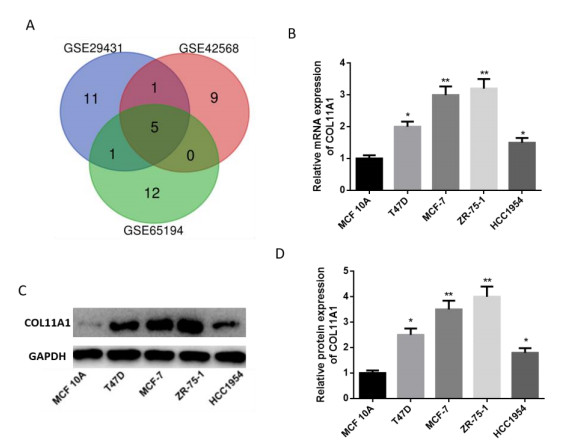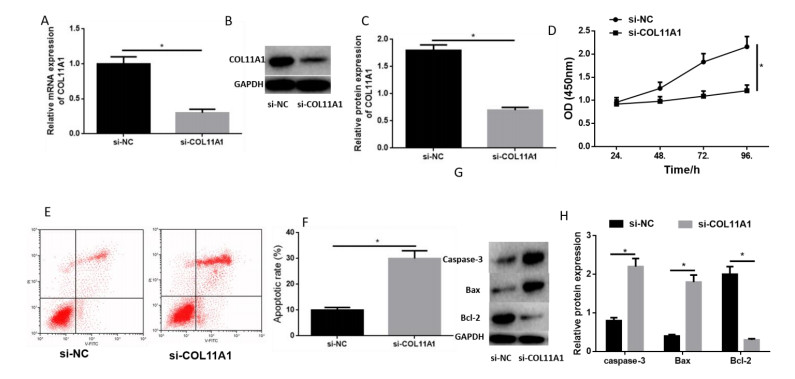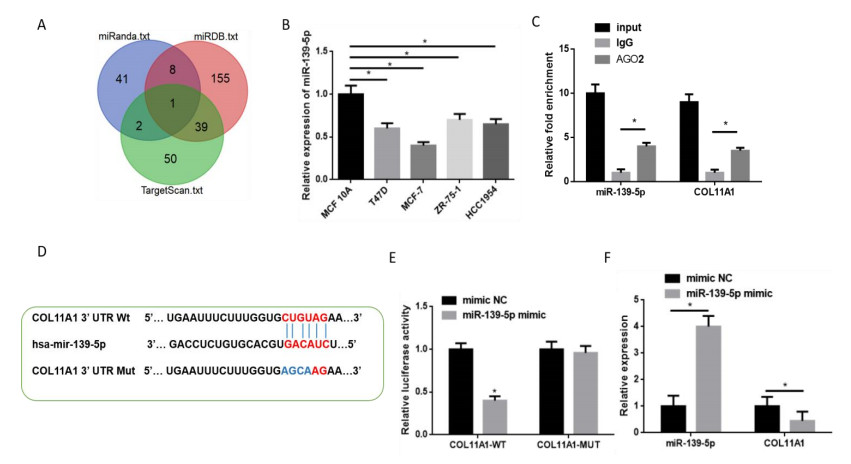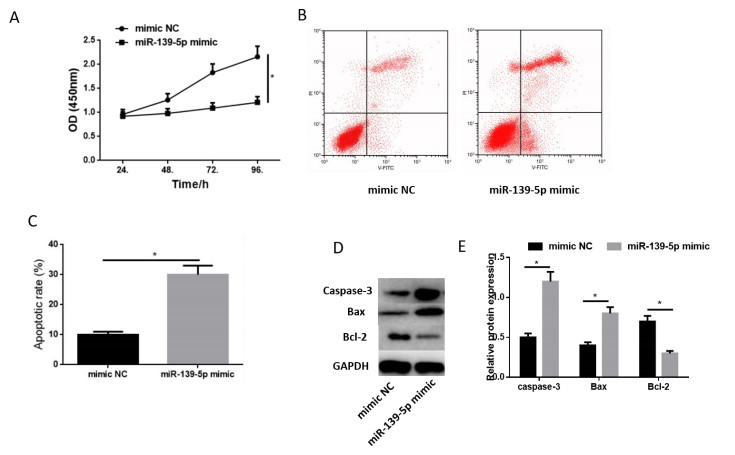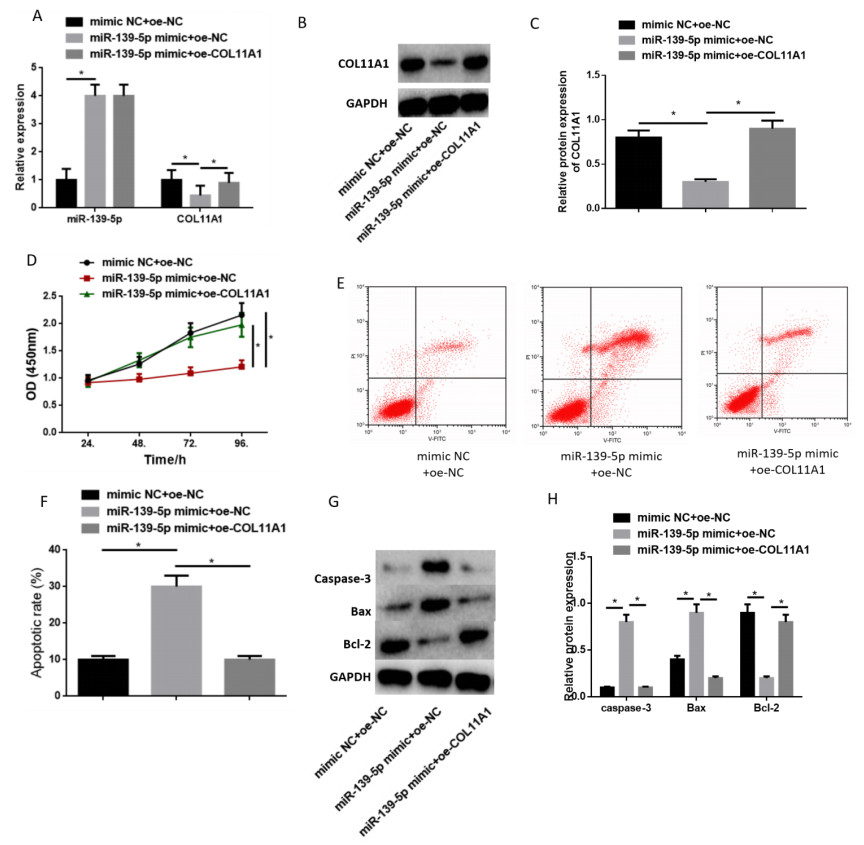1.
Introduction
Breast cancer is a major threat to women's health, with an annual morbidity accounting for nearly 11.6% of the world. In China, the morbidity of middle-aged women continuously increases, and more and more young women are involved in [1]. At present, the study on the breast cancer-related molecular mechanism has been highly focused, especially on the role of miRNA in breast cancer [2]. Previous studies have shown that miRNAs play an important role in the invasion and metastasis of various malignant tumors [3]. For example, the overexpression or knockout of miR-503 partially regulates apoptotic activity and alters the resistance of ovarian cancer cells to cisplatin [4]. MiR-1266 promotes the progression of pancreatic cancer and chemotherapy resistance via STAT3/NF-κB axis [5]. Moreover, miR-139-5p has been reported to be associated with lung cancer [6], breast cancer [7], prostate cancer [8] and other diseases.
Collagen is the main component of interstitial extracellular matrix. It is well known that extracellular matrix plays an active role in various biological processes, such as cell morphology, proliferation, migration, differentiation, apoptosis and carcinogenesis [9]. Collagen I, for instance, promotes cell metastasis in pancreatic cancer by activating terminal kinase 1 of c-Jun NH2 and up-regulating the expression of N-cadherin [10]. In addition, specific collagens like collagen type Ⅰ and type Ⅲ can promote metastasis of pancreatic cancer cells by down-regulating the expression of E-cadherin gene in a Src kinase dependent fashion [11]. COL11A1, a member of small fibre collagen, is encoded by COL11A1 gene located on chromosome 1p21, and can be produced by cartilage and various non-cartilage tissues like bone, vitreous, skin and heart [12]. In recent years, studies have found that COL11A1 is associated with the tumorigenesis and development, and plays an important role in biological processes like cell proliferation and invasion [13]. However, whether miR-139-5p can affect the biological characteristics of breast cancer cells by targeted regulating COL11A1 has not been reported.
In this study, we found that COL11A1 was highly expressed in breast cancer through the bioinformatics analysis. The targeted relationship between COL11A1 and miR-139-5p was predicted by prediction websites, which provided a target for clinical research on the biological characteristics of breast cancer. Our research may provide new insight into the pathogenesis of breast cancer and theoretical basis for a new direction of targeted therapy.
2.
Materials and methods
2.1. Bioinformatics analysis
Three gene expression chips of breast cancer were obtained from the GEO database (https://www.ncbi.nlm.nih.gov/geo/), including GSE65194 (178 arrays) [14], GSE42568 (104 breast cancer and 17 normal breast biopsies) [15] and GSE29431 (54 primary breast carcinomas samples). GEO2R (http://www.ncbi.nlm.nih.gov/geo/geo2R/) was employed to screen differentially expressed genes (DEGs) with the criterion of |LogFC| > 1 and adj P-value < 0.01. miRDB (http://www.mirdb.org/microDB/policy.html), miRanda (http://www.microrna.org/microrna/home.do) and TargetScan databases (http://www.targetscan.org/vert_71/) were employed to predict the regulatory miRNAs of COL11A1.
2.2. Cell culture and transfection
Human normal breast epithelial cell MCF 10A (CBP60419) and human breast cancer cell lines T47D (CBP60397), MCF-7 (CBP60380), ZR-75-1 (CBP60402) and HCC1954 (CBP60374) were purchased from Nanjing CoBioer Co., Ltd. Cancer cells in logarithmic phase were grouped as follows: si-NC group, si-COL11A1 group, mimic NC group, miR-139-5p mimic group, mimic NC+oe-NC group, miR-139-5p mimic+oe-NC group, and miR-139-5p mimic+oe-COL11A1 group. Plasmids such as si-NC, si-COL11A1, mimic NC, miR-139-5p mimic, oe-NC and oe-COL11A1 were all purchased from Shanghai GenePharma Co., Ltd.
2.3. qRT-PCR
Total RNA was extracted by Trizol (No. 16096020, ThermoFisher Scientific, New York, USA), 5 µg among which was reversely transcribed to cDNA with the cDNA kit (K1622; Fermentas Inc., Ontario, CA, USA). qRT-PCR was carried out using TaqMan MicroRNA Assay and TaqMan® Universal PCR Master Mix: 95 ℃ for 2 min, followed by 45 cycles at 95 ℃ for 15 s, 60 ℃ for 45 s and 72 ℃ for 45 s. U6 was used as internal reference.
qRT-PCR was carried out based on the instruction of TaqMan Gene Expression Assays protocol (Applied Biosystems, Foster City, CA, USA). GAPDH was taken as internal reference. The programming of PCR was as below: 95 ℃ for 10 min, followed by 35 cycles at 95 ℃ for 15 s, 60 ℃ for 30 s and 72 ℃ for 45 s. 3 compounds were set for both qRT-PCR reactions. Primers designed were showed in Table 1. Relatively quantitative method(2 - △△CT)was used to calculate the relative transcription level of target gene: △△Ct = △Ct (experimental group) - △Ct (control group), △Ct = Ct (target gene) - Ct (internal reference), relative transcription level of target gene mRNA = 2 - △△Ct [16].
2.4. Western blot
Total protein was extracted from cells, and the protein concentration was determined by BCA kit (Thermo, USA). 30 μg of the total protein was separated by polyacrylamide gel electrophoresis with a constant voltage of 80 V for 35 min, followed by 120 V for 45 min, and then transferred onto the PVDF membrane (Amersham, USA). The membrane was blocked with 5% skim milk at room temperature for 1h. COL11A1 rabbit polyclonal antibodies (1:1000, abcam, Cambridge, UK), Caspase-3 mouse monoclonal antibodies (1:500, abcam, Cambridge, UK), Bax mouse monoclonal antibodies (1:1000, abcam, Cambridge, UK), Bcl-2 mouse monoclonal antibodies (1:500, abcam, Cambridge, UK) and GAPDH rabbit monoclonal antibodies (1:10000, abcam, Cambridge, UK) were added onto the membrane for incubation overnight at 4 ℃. PBST buffer (containing 0.1% Tween-20 of PBS buffer) was used to wash the membrane three times. Then, the membrane was incubated with the secondary antibody horseradish peroxidase-labeled goat anti-rabbit IgG H & L (HRP) (1:3000, abcam, Cambridge, UK) or goat anti-mouse IgG H & L (HRP) (1:3000, abcam, Cambridge, UK) at room temperature for 1 hour. Optical Luminiferous Instrument (GE, USA) was used to visualize the protein bands, and Image Pro Plus 6.0 (Media Cybernetics, USA) software was used to analyze the relative expression of protein by gray-scale scanning.
2.5. CCK-8
The transfected breast cancer cells were digested and resuspended to a concentration of 1×105 cells/mL and cultured in 96-well plates (100 μL/well) overnight. 10 μL of CCK-8 (Beyotime, Shanghai, China) was added into the wells at 24, 48, 72 and 96 hours, respectively. The absorbance at 450 nm was measured by enzyme label and the growth curve was drawn.
2.6. Flow cytometry
After 48 hours of transfection, cells were digested with 0.25% tryptase (EDTA-free) (YB15050057, Yubo, Shanghai, China) and collected in flow tubes. Then the cells were centrifuged and the supernatant was discarded. Cold PBS was used to wash cells 3 times. The cells were subsequently centrifuged for the second time. According to the instruction of Annexin-V-FITC cell apoptosis detection kit (K201-100, Biovision, USA), Annexin-V-FITC, PI and HEPES buffer solution were prepared into Annexin-V-FITC/PI dye solution at the ratio of 1:2:50. 1×106 of cells were resuspended in 100μL of the dye solution. After incubation at room temperature for 15 min, 1mL of HEPES buffer (PB180325, Procell, Wuhan, China) was added to the cells. FITC and PI fluorescence were detected by 525 and 620 nm of band-pass filters that were excited by 488 nm excitation light. The experiment was repeated three times [17].
2.7. RNA binding protein immunoprecipitation (RIP)
RIP kit (Millipore, USA) was used to detect the binding relationship between miR-139-5p and COL11A1. Cells were firstly washed with pre-cooled PBS and the supernatant was discarded. Pyrolysis solution (P0013B, Bi Yun Tian) of equal volume was used to lyse cells on ice for 5 min, and proteins obtained were centrifuged at 14,000 rpm and 4 ℃ for 10 min. One part of the cell extract was taken out as input and the other part was taken out to incubate and co-precipitate with antibodies. The specific steps were as follows: 50 μL of the co-precipitation was washed with magnetic beads and then resuspended in 100 μL of RIP Wash Buffer. According to the experimental grouping, 5 μg of antibodies was added into the tubes to form the magnetic beads-antibody complex, which was then resuspended in 900 μL of RIP Wash Buffer after washed, and incubated with 100 μL cell extract at 4 ℃ overnight. The complex was collected. The antibodies used in RIP were Ago2 (ab32381, 1:50, Abcam, UK) and IgG (1:100, ab109489, Abcam, UK). The samples Input were digested by protease K, then RNA was extracted for subsequent PCR detection.
2.8. Dual-luciferase reporter gene assay
The full length of COL11A1 3'UTR region was amplified. The PCR products were cloned into the luciferase pmirGLO (Promega, WI, USA) vector with endonuclease sites, Spe I and Hind Ⅲ, and the COL11A1-WT was constructed. The target gene database was used to predict the binding sites of miR-139-5p on the target gene, and the COL11A1-MUT vector was constructed by site-directed mutagenesis through PCR. Then luciferase reporter vector was co-transfected with each plasmid into HEK-293T cells, respectively, with Renilla luciferase expression vector pRL-TK (TaKaRa, Dalian, China) as internal reference. The dual-luciferase activity was examined using Promega's Digital-Luciferase Reporter Assay System (Promega, Madison, WI, USA). The experiment was repeated three times.
2.9. Statistical analysis
All data were processed by SPSS 21.0 statistical software (SPSS, Inc., Chicago, IL, USA). Measurement data were expressed in the form of mean value ± standard deviation (SD). Comparison between two groups was performed by t test, and comparison among multiple groups was performed by one-way ANOVA. The counting data was analyzed by chi-square test. P < 0.05 was considered statistically significant.
3.
Results
3.1. High expression of COL11A1 in breast cancer cells
The first 10 significantly up-regulated DEGs and 10 down-regulated DEGs of each chip (GSE65194, GSE42568, GSE29431) were selected to make a Venn diagram. Five DEGs were obtained, containingFABP4, RBP4, ADH1B, COL11A1 and LEP, of which COL11A1 was the only significantly highly-expressed gene (Figure 1A). The expression of COL11A1 in human normal breast epithelial cell, MCF 10A, and human breast cancer cell lines, T47D, MCF-7, ZR-75-1 and HCC1954, were detected by qRT-PCR. As shown in Figure 1B, compared with MCF 10A, the expression of COL11A1 mRNA were significantly up-regulated in breast cancer cell lines. Meanwhile, the protein levels of COL11A1 in all cell lines were tested by Western Blot. As shown in Figure 1C and 1D, COL11A1 protein level in breast cancer cell lines were significantly up-regulated by the comparison with normal cells. These results indicated that COL11A1 was highly expressed in breast cancer cell lines, and ZR-75-1, the cell line with the highest expression of COL11A1, was selected for subsequent experiments.
3.2. Silencing COL11A1 inhibits cell proliferation and promotes apoptosis in breast cancer
To investigate the effect of COL11A1 on the biological characteristics of breast cancer cells, we firstly silenced COL11A1 in breast cancer cell line, ZR-75-1. Results of qRT-PCR and WB (Figure 2A-C) showed that, the mRNA and protein expression of COL11A1 in the si-COL11A1 group was significantly lower than that in the si-NC group. Then CCK-8 method was used to detect the proliferation of ZR-75-1. As shown in Figure 2D, compared with si-NC group, the proliferation ability of ZR-75-1 cells in si-COL11A1 group was significantly decreased. Meanwhile, flow cytometry (Figure 2E, F) suggested that cells in si-COL11A1 group had significantly higher apoptotic rate. WB assay was performed to detect the expression of apoptosis-related proteins Caspase-3, Bax and Bcl-2. As shown in Figure 2G, H, compared with si-NC group, the protein levels of Caspase-3 and Bax in the si-COL11A1 group were significantly up-regulated, while the level of anti-apoptosis protein Bcl-2 was significantly down-regulated. These results suggested that silencing COL11A1 could inhibit the proliferation and promote the apoptosis of breast cancer cells.
3.3. miR-139-5p targets the expression of COL11A1
In order to further study the regulatory mechanism of COL11A1 in breast cancer cells, three databases miRDB, miRanda and TargetScan databases were employed to predict the regulatory miRNAs of COL11A1. Venn diagram was made, and miR-139-5p was finally obtained (Figure 3A). Therefore, we hypothesized that miR-139-5p may regulate the biological characteristics of breast cancer cells by targeted inhibiting the expression of COL11A1. To verify our hypothesis, qRT-PCR was performed to test the expression of miR-139-5p in human normal breast epithelial cell and breast cancer cell lines. As shown in Figure 3B, compared with MCF-10A, the expression of miR-139-5p was much lower in breast cancer cell lines. Furthermore, RIP assay was carried out to verify that miR-139-5p could bind with COL11A1 (Figure 3C), and TargetScan website (http://www.targetscan.org/vert_71/) was applied to predict the binding sites of the two genes (Figure 3D). Dual-luciferase reporter gene assay was then carried out, and the results shown in Figure 3E suggested that miR-139-5p overexpression could significantly inhibit the luciferase activity of effect on COL11A1-MUT. Meanwhile, qRT-PCR was used to detect the expression of miR-139-5p and COL11A1 after miR-139-5p overexpressed in ZR-75-1. As shown in Figure 3F, compared with mimic NC group, the expression of miR-139-5p in miR-139-5p mimic group was significantly up-regulated, while COL11A1 was significantly down-regulated. These findings suggested that miR-139-5p could targeted inhibit the expression of COL11A1.
3.4. miR-139-5p overexpression inhibits the proliferation and promotes the apoptosis of breast cancer cells
In order to investigate the effect of miR-139-5p on the biological characteristics of breast cancer cells, miR-139-5p was firstly overexpressed in ZR-75-1 cells. Results of CCK-8 (Figure 4A) indicated that cells in the miR-139-5p mimic group had significant lower proliferation in comparison with that in the mimic NC group. At the same time, flow cytometry was used to detect the apoptotic rate of ZR-75-1 cells. As shown in Figure 4B, C, compared with mimic NC group, the apoptotic rate was significantly increased in the miR-139-5p mimic group. WB (Figure 4D, E) was applied to examine the protein levels of Caspase-3, Bax and Bcl-2, finding that the expression of Caspase-3 and Bax in miR-139-5p mimic group were significantly up-regulated, while that of Bcl-2 was significantly down-regulated. These results suggested that overexpressing miR-139-5p could inhibit the proliferation and promote the apoptosis of breast cancer cells.
3.5. miR-139-5p Overexpression inhibits the proliferation and promotes the apoptosis of breast cancer cells through inhibiting COL11A1
To investigate the role of miR-139-5p/COL11A1 axis in breast cancer, miR-139-5p and COL11A1 were simultaneously overexpressed in ZR-75-1 cells. qRT-PCR was performed to detect the expression of miR-139-5p and COL11A1, and WB was carried out for the examination of COL11A1 protein level. As shown in Figure 5A-C, compared with mimic NC+oe-NC group, the expression of miR-139-5p in the miR-139-5p mimic+oe-NC group was significantly up-regulated, while the mRNA expression and protein level of COL11A1 were both down-regulated. In addition, in the miR-139-5p mimic+oe-COL11A1 group, the down-regulation of COL11A1 caused by miR-139-5p was reversed. Subsequently, CCK-8 was performed to test the cell proliferation, finding that cells in the miR-139-5p mimic+oe-NC group had poorer proliferation ability than those in the mimic NC+oe-NC group, and such effect could be reversed by simultaneously overexpressing miR-139-5p and COL11A1 (Figure 5D). Furthermore, WB and flow cytometry were employed for cell apoptosis detection as shown in Figure 5E-H. Results suggested that miR-139-5p overexpression could promote cell apoptosis, and overexpressing COL11A1 at the same time could make the apoptosis rate back to the level near that in the control group. All these findings indicated that overexpression of miR-139-5P could inhibit cell proliferation and promote cell apoptosis in breast cancer, and such effect could be reversed through overexpressing COL11A1.
4.
Discussion
Breast cancer is an agammaessive disease that seriously threatens human health. Despite the continuous improvement of the treatment, the morbidity of breast cancer is still high. Studies have shown that invasion and metastasis are the key factors leading to death in breast cancer patients [18]. Recently, research on the mechanism of breast cancer has attracted much attention, especially on the way of controlling the invasion and metastasis, cancer prevention, therapeutic methods and the improvement of the survival rate and life quality of patients [19]. Therefore, it is very important to study the molecular mechanism of breast cancer.
In this study, we found that COL11A1 was highly expressed in breast cancer cell lines, and silencing COL11A1 could inhibit cell proliferation and promote apoptosis. It is reported that COL11A1 is up-regulated in various cancers, such as colorectal cancer [9], pancreatic cancer [20], and non-small cell lung cancer [21]. Moreover, high expression of COL11A1 has been found to be closely related with various malignancies like ovarian cancer [22] and lung cancer [23]. For example, COL11A1 is over expressed in gastric cancer and regulates the proliferation, migration and invasion of HGC-27 gastric cancer cells in vitro [24]. While in ovarian cancer, COL11A1 can activate TWIST1 to regulate the expression of NF-kB-mediated IKK β, thereby promoting cell chemotherapy resistance and inhibiting apoptosis [25].
miRNAs are small non-coding RNAs with a length of about 19-24 nucleotides, which work in cells by scavenging mRNAs or inhibiting the translation process [26]. For example, miRNA-188-5p inhibits cell proliferation and promotes apoptosis of breast cancer cells via the MAPK signaling pathway by targeting Rap2c [27]; miR-483-3p suppresses the proliferation and progression of human triple negative breast cancer cells by targeting the HDAC8 oncogene [28]; miRNA-326 is decreased in breast cancer tissues, and plays an anti-tumor role in breast cancer by targeting ErbB/PI3K Signaling Pathway [29]. In this study, we predicted that miR-139-5p could target COL11A1, and be involved in regulating the biological characteristics of breast cancer cells. Several studies have shown that miR-139-5p is closely related to many diseases, such as colon cancer [30], uterine cancer [31], bladder cancer [32]. In addition, miR-139-5p is significantly down-regulated in breast cancer cells, and inhibits the cell proliferation, metastasis as well as induces apoptosis, leading to cell cycle arrested in S phase. In breast cancer, miR-139-5p not only attenuates the development of breast cancer cells but also mediates drug-resistance by regulating the expression of the target gene Notch1 in the downstream [33]. Moreover, another study has shown that miR-139-5p plays an important role in the migration and invasion of breast cancer cells, and may serve as a prognostic marker for invasive breast cancer [34].
In this study, miR-139-5p was found to be poorly expressed in breast cancer cells, and targeted inhibit the expression of COL11A1. Silencing COL11A1 or overexpressing miR-139-5p could inhibit the proliferation and promote the apoptosis of breast cancer cells, while overexpressing miR-139-5p and COL11A1 simultaneously could reverse such effect. The findings could provide a new theoretical basis for further research on the mechanism of the occurrence and development of breast cancer cells.
Acknowledgements
None
Conflict of interest
The authors declare that they have no conflict of interest.









 DownLoad:
DownLoad:
